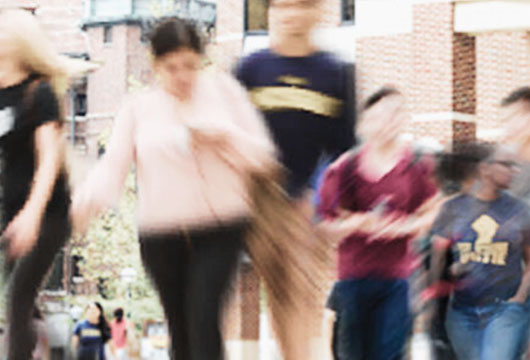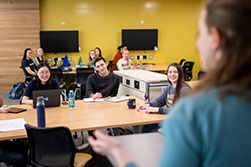 The research is clear that peer cooperation promotes learning and can foster students' appreciation of diverse perspectives. But how to get students on board to realize the full benefits of working with their peers?
The research is clear that peer cooperation promotes learning and can foster students' appreciation of diverse perspectives. But how to get students on board to realize the full benefits of working with their peers?
In other blog posts, CRLT has featured some effective strategies for structuring group work and guiding student pairs. Here, we highlight one U-M instructor who is applying those strategies to foster group work that has won high praise from her students and, by their account, facilitated their success with the most challenging aspects of the course.
Cynthia (Cindee) Giffen, who teaches Biology 171 in the Comprehensive Studies Program, assigns her students to in-class working groups that change several times a semester. The class includes students with a diverse range of background preparation, and the groups are designed to provide a safe space for students to work through complex activities, ask questions, and make mistakes in a low-risk environment as they prepare for individual assessments. Giffen requires students to work on complex tasks in groups during class. Students receive a participation grade for their engagement in the group activities, but all written work they submit for a grade is completed individually, using their own words. Students are motivated to work in these groups, then, in part because these low-stakes interactions prepare them to submit their best work when it's time to earn a grade.

Overwhelmingly, Giffen's students reported on an end-of-term survey that they found the in-class groups helpful for their learning (79% agree). Students cited the following values to this regular group work:
- they learn from hearing other students explain the concepts
- they learn from explaining concepts to peers
- group work is helpful for approaching difficult or confusing concepts because every group member contributes something different
- students can teach each other new ways to learn and apply content.
These students' responses illustrate what scholarship on peer instruction has shown: 1. Better ideas and more robust solutions emerge when multiple students bring their knowledge and perspectives to the table. 2. Students gain confidence when given the opportunity to explore ideas and think through questions in small groups before presenting them in class or as part of an individual written assignment. 3.Students engage in higher-order critical thinking when given the opportunity to think through problems with peers from diverse backgrounds before drawing conclusions and/or identifying solutions.

Giffen often observes that students are more willing to ask questions of peers than of her, especially if they're worried the question demonstrates lack of knowledge. And the process of helping peers learn can itself be a powerful learning activity. In her words, "one of the powers of a group is to help uncertain students gain confidence in their understanding and abilities."
Student groups have been so helpful and effective in Giffen's course that she's integrated them into her office hours. For those who want to discuss course concepts outside of class, she offers group office hours. Anecdotally, students have reported appreciating this structure because hearing others' questions can help stimulate their own, and they can check their own learning as they formulate answers to their peers' questions.
Some questions you might reflect on as you consider the use of small groups in your classroom:
- How do your course objectives or learning goals lend themselves to group work as a method of learning?
- How will you organize your students into groups?
- Will students remain in the same group throughout the semester or will the groups change?
- Will students be assigned particular roles or responsibilities in their group?
- How will you grade group assignments? Will you include a self- or group-evaluation as a component of assessment?
For more on designing effective student groups and teams, see this CRLT Occasional Paper or click on the "Group Work" tag below.
- Log in to post comments
- 39 views






